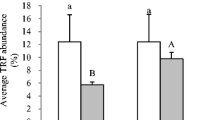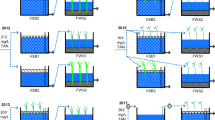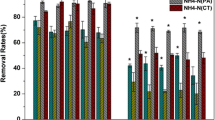Abstract
To control potential fungal denitrification rate (PFDR) in vertical flow simulated wetlands (VFSW) microcosms, thirty VFSW microcosms were established and planted with three plant species richness levels (i.e. unplanted, monoculture, and four-species polyculture treatment), and effects of carbon, nitrogen and pH amendments on the PFDR were investigated using a room-incubating method. Among seven carbon compounds, sodium citrate, glycerol, glucose and sodium succinate were more effective in enhancing PFDRs. These enhanced effects were dependant on a given species richness level. Sodium nitrite mostly stimulated PFDRs to a greater extent than the other three nitrogen compound amendments at any richness level. Treatments with pH 5.6 or 8.4 had significantly greater PFDRs than the treatment with pH 2.8 in the three species richness levels. However, no effect of plant species richness on the PFDR was observed among any carbon, nitrogen and pH amendments. Current results suggest carbon, nitrogen and pH factors should be considered when mediating fungal denitrification in VFSW microcosms.



Similar content being viewed by others
References
Baggs EM, Smales CL, Bateman EJ (2010) Changing pH shifts the microbial source as well as the magnitude of N2O emission from soil. Biol Fertil Soils 46:793–805
Bais HP, Weir TL, Perry LG et al (2006) The role of root exudates in rhizosphere interactions with plants and other organisms. Annu Rev Plant Biol 57:233–266
Castaldi S, Smith KA (1998) Effect of cycloheximide on N2O and NO3 – production in a forest and an agricultural soil. Biol Fert Soils 27(1):27–34
Chang J, Fan X, Sun HY et al (2014) Plant species richness enhances nitrous oxide emissions in microcosms of constructed wetlands. Ecol Eng 64:108–115
Čuhel J, Šimek M, Laughlin RJ et al (2010) Insights into the effect of soil pH on N2O and N2 emissions and denitrifier community size and activity. Appl Environ Microbiol 76(6):1870–1878
Faulwetter JL, Gagnon V, Sundberg C et al (2009) Microbial processes influencing performance of treatment wetlands: a review. Ecol Eng 35:987–1004
Haichar FZ, Santaella C, Heulin T et al (2014) Root exudates mediated interactions belowground. Soil Biol Biochem 77(7):69–80
Herold MB, Baggs EM, Daniell TJ (2012) Fungal and bacterial denitrification are differently affected by long-term pH amendment and cultivation or arable soil. Soil Biol Biochem 54(6):25–35
Liu WL, Guan M, Liu SY et al (2015) Fungal denitrification potential in vertical flow microcosm wetlands as impacted by depth stratification and plant species. Ecol Eng 77:163–171
Marschner H, Römheld V (1983) In vivo measurement of root-induced pH changes at the soil-root interface: effect of plant species and nitrogen source. Zeitschrift für Pflanzenphysiologie 111:241–251
McLain JET, Martens DA (2006) N2O production by heterotrophic N transformations in a semiarid soil. Appl Soil Ecol 32(2):253–263
Seo DC, DeLaune RD (2010) Fungal and bacterial mediated denitrification in wetlands: Influence of sediment redox condition. Water Res 44(8):2441–2450
Shoun H, Suyama W, Yasui T (1991) Soluble, nitrate/nitrite-inducible cytochrome P-450 of the fungus, Fusarium oxysporum. FEBS Lett 244:11–14
Song K, Hernandez ME, Batson JA et al (2014) Long-term denitrification rates in created riverine wetlands and their relationship with environmental factors. Ecol Eng 72:40–46
Vymazal J (2011) Constructed wetlands for wastewater treatment: five decades of experience. Environ Sci Technol 45(1):61–69
Wei W, Isobe K, Shiratori Y et al (2014) N2O emission from cropland field soil through fungal denitrification after surface applications of organic fertilizer. Soil Biol Biochem 69(1):157–167
Yang JX, Liu Y, Ye ZH (2012) Root-induced changes of pH, Eh, Fe(II) and fractions of Pb and Zn in rhizosphere soils of four wetland plants with different radial losses. Pedosphere 22(4):518–527
Zhang CB, Ke SS, Wang J et al (2011) Responses of microbial activity and community metabolic profiles to plant functional group diversity in a full-scale constructed wetland. Geoderma 160(s3–s4):503–508
Acknowledgements
This work was funded by the Natural Science Foundation of Zhejiang Province (LY17D010001) and National Natural Science Foundation of China (51279121).
Author information
Authors and Affiliations
Corresponding author
Rights and permissions
About this article
Cite this article
Liu, W.L., Zhang, C.B., Han, W.J. et al. Fungal Denitrification Activity in Vertical Flow Constructed Wetlands as Impacted by Plant Species Richness, Carbon, Nitrogen and pH Amendments. Bull Environ Contam Toxicol 99, 748–752 (2017). https://doi.org/10.1007/s00128-017-2207-2
Received:
Accepted:
Published:
Issue Date:
DOI: https://doi.org/10.1007/s00128-017-2207-2




